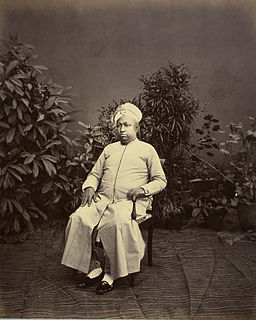
The Kingdom of Travancore (Thiruvithamkoor) was an Indian kingdom from 1500 until 1949. It was ruled by the Travancore Royal Family from Padmanabhapuram, and later Thiruvananthapuram. At its zenith, the kingdom covered most of modern-day central and southern Kerala with the Thachudaya Kaimal's enclave of Irinjalakuda Koodalmanikkam temple in the neighbouring Kingdom of Cochin, as well as the district of Kanyakumari, now in the Indian state of Tamil Nadu. The official flag of the state was red with a dextrally-coiled silver conch shell at its center. In the early 19th century, the kingdom became a princely state of the British Empire. The Travancore Government took many progressive steps on the socio-economic front and during the reign of Maharajah Sri Chithira Thirunal Balarama Varma, Travancore became the second most prosperous princely state in British India, with reputed achievements in education, political administration, public work and social reforms.
Rama is the legendary Indian king regarded as an incarnation of Vishnu.

Svāti Tirunāḷ Rāma Varma was the Maharaja of the Kingdom of Travancore, British India. He is also considered as a brilliant music composer and is credited with over 400 classical compositions in both Carnatic and Hindustani style.

Kochi is a small city located in the Ernakulam District in the Indian state of Kerala. Trivandrum which is the capital and largest city of Kerala is 200km away from Kochi.

Raja Kesavadas was the Dewan of Travancore during the reign of Dharma Raja Karthika Thirunal Rama Varma. He is well known for his planning skills and administrative acumen. He was the master mind in developing the Alappuzha town.

Ayilyam Thirunal Rama Varma (1832–1880) was the ruler of the princely state of Travancore in India from 1860 to 1880. His reign was highly successful with Travancore gaining the appellation of "model state of India". Ayilyam Thirunal was the nephew of Uthram Thirunal and Swathi Thirunal and grandson of the celebrated Gowri Lakshmi Bayi.

Mulam Thirunal Rama Varma was the ruling Maharajah of the Indian state of Travancore between 1885 and 1924, succeeding his uncle Maharajah Visakham Thirunal (1880–1885).

Visakham Thirunal Rama VarmaFRAS was the Maharaja of the erstwhile Indian kingdom of Travancore from 1880–1885 AD. He succeeded his elder brother Maharajah Ayilyam Thirunal to the throne of Travancore.
Rajah Rama Varma was the ruler of the Indian kingdom of Venad, later known as Travancore, in the modern day state of Kerala, India between 1724 and 1729, having succeeded his brother Unni Kerala Varma. He is better known as the uncle of Maharajah Padmanabha Dasa Vanchi Pala Marthanda Varma Kulasekhara Perumal, the "maker of modern Travancore". He was born as the second son of Rajah Ittamar of Thattari Kovilakam into the Royal Family of Kolathunadu. His entire family, including himself, two sisters and his elder brother Unni Kerala Varma, were adopted into the Venad house as members of the Travancore Royal Family by Rajah Ravi Varma, nephew of Umayamma Rani due to their failure of heirs there. Of his sisters, one died soon after her adoption while the other was the mother of the Maharajah Marthanda Varma.

Sir Amaravati Seshayya Sastri, or Sashiah Sastri, was an Indian administrator who served as the Diwan of Travancore from May 1872 to 4 May 1877 and as the Diwan of Pudukkottai from 1878 to 1894. He is credited with having modernized the city of Pudukkottai.

The Travancore Royal Family was the ruling house of the Kingdom of Travancore. They lost their ruling rights in 1949 when Travancore merged with the Indian Union and their privileges were abolished by the Indian Union in 1971 by a constitutional amendment. Travancore and Kolathiri families are said to be those surviving among the original royal Nair Family's lineages, and are both descendants of the Ay/Venad Family, Cheras, Pandyas and Cholas. The ruler in that bloodline was Maharaja Sree Moolam Thirunal, as the family of Maharaja Chithira Thirunal and successors.

Tanjore Rama Rao was an Indian administrator who served as the Diwan of Travancore from 1887 to 1892. V. Nagam Aiya, in his 1906 Travancore State Manual calls him "the most popular Diwan in recent times". Rama Rao was a cousin of Rajah Sir T. Madhava Rao and Diwan Bahadur R. Raghunatha Rao. All three were grandsons of Gundopanth. Rama Rao's mother Sonamma Bai was Gundopanth's daughter, while Diwan Bahadur R. Raghunatha Rao's father Rai Raya Rai Venkat Rao and Sir. T. Madhava Rao's father Ranga Rao were Gundopanth's sons.
Rama Varma XII was an Indian monarch who ruled the Kingdom of Cochin from 1837 to 1844.
Ravi Varma IV was an Indian monarch who ruled the Kingdom of Cochin from 1853 to 1864.

Sir Rama Varma XIVKCSI (1848–1888) was the ruler of the Kingdom of Cochin from 1864 to 1888. He was the first Maharajah of Cochin to be knighted.

Sir Sri Rama Varma XVI was the ruler of the Kingdom of Cochin from 1915 to 1932.

Sree Padmanabhadasa Sree Moolam Thirunal Rama Varma is the current titular Maharajah of Travancore. He is the youngest of the four children of the former Titular Maharani of Travancore, H.H. Sree Padmanabhasevini Maharani Karthika Thirunal Lakshmi Bayi and her husband, Prince Consort Lt. Col. G. V. Raja of Poonjar Royal House.













